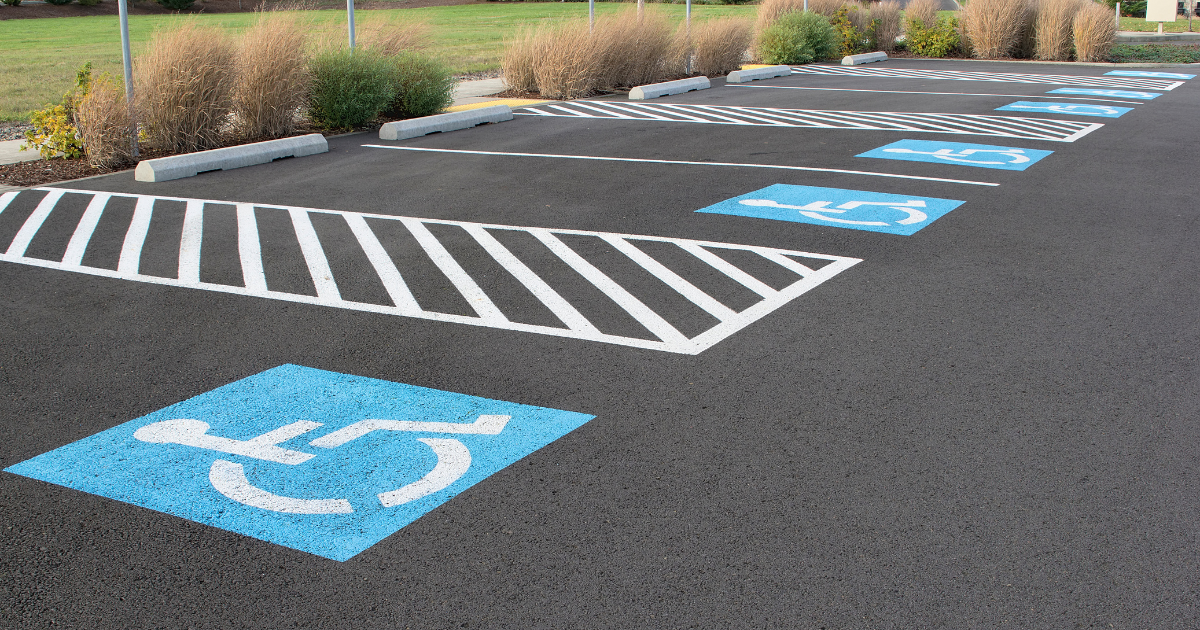What is the ADA?
The Americans with Disabilities Act (ADA) was passed in 1990 to ensure that individuals with disabilities have equal access to public spaces. This includes parking lots, which are often the first point of contact for people visiting businesses, government buildings, and other public facilities. In this blog post, we’ll take a look at the specific requirements for parking lot accessibility under the ADA in New Jersey.

Designing an ADA Compliant Parking Lot**
Designing an ADA compliant parking lot requires careful consideration of various factors, such as the size and layout of the parking lot, the number of parking spaces required, and the accessibility features needed to accommodate people with disabilities. Here are some important guidelines to keep in mind when designing an ADA compliant parking lot:
-
Number of Accessible Parking Spaces: The number of accessible parking spaces required in a parking lot is based on the total number of parking spaces in the lot. The ADA requires that at least one accessible parking space be provided for every 25 parking spaces, or fraction thereof. For example, if a parking lot has 100 spaces, it must have at least four accessible parking spaces.
-
Accessible Parking Space Dimensions: Accessible parking spaces must be designed to accommodate people with disabilities, including those who use wheelchairs or other mobility devices. The minimum size for an accessible parking space is 96 inches wide, with an adjacent access aisle that is at least 60 inches wide. The access aisle provides space for individuals to transfer from their vehicle to a mobility device, such as a wheelchair. The number of accessible parking spaces required is determined by the total number of parking spaces in the lot. For example, if a parking lot has 26 to 50 parking spaces, it must have at least two accessible parking spaces. If the lot has 51 to 75 parking spaces, it must have at least three accessible parking spaces, and so on.
-
Van-Accessible Parking Spaces: In addition to standard accessible parking spaces, parking lots must also provide van-accessible parking spaces. Van-accessible spaces must have a minimum width of 96 inches and an adjacent access aisle that is at least 96 inches wide. These Van-accessible spaces must be provided in parking lots for people with disabilities who use vans with wheelchair lifts or ramps.
-
Accessible Parking Space Markings: Accessible parking spaces and access aisles must be clearly marked with the International Symbol of Accessibility. The markings must be located on the ground in a visible location and must be maintained to ensure visibility.
-
Accessible Routes: Accessible routes must be provided from accessible parking spaces to the entrance of the building or facility. The route must be at least 36 inches wide and must be free of obstructions, such as curbs or steps. In addition, accessible routes must have a firm, stable, and slip-resistant surface, and must be free of any changes in level greater than ¼ inch. Accessible routes must also be clearly marked with the international symbol of accessibility.
-
Curb Ramps: Curb ramps must be provided at all locations where a pedestrian walkway crosses a curb or other barrier. The ramp must be at least 36 inches wide and have a slope of no more than 1:12.
-
Signage: Signage must be provided to indicate the location of accessible parking spaces and accessible routes. The signs must be placed at a height of 60 inches above the ground and must be clearly visible.
-
Parking Lot Lighting: Parking lots must be well-lit to ensure that people with disabilities can safely navigate the parking lot. The lighting must be sufficient to provide a minimum of 1 foot-candle of illumination at the ground level.
An accessible parking lot is essential for ensuring that individuals with disabilities have equal access to public spaces. Designing an ADA compliant parking lot and maintaining and enforcing its accessibility features is critical to ensuring that it remains usable for all. Property owners and businesses must take the necessary steps to create and maintain an accessible parking lot, including providing adequate parking spaces, access aisles, and curb ramps, as well as properly maintaining signage and markings and enforcing their use. By doing so, they can create a welcoming and inclusive environment for all individuals. To read more about ADA compliance, check out the Accessible Parking Spaces on the ADA.gov site.
If you need help designing, constructing, or maintaining an ADA compliant parking lot in New Jersey, consider contacting Asphaltech Pavement Solutions. With years of experience and a team of experts, they can provide guidance on meeting ADA requirements and ensuring your parking lot is safe and accessible for all. Contact us today to learn more.
** DISCLAIMER: This article is for informational purposes only and is not intended to provide legal advice. You should consult an attorney to obtain advice with respect to any particular issue or problem as well as reference the ADA.gov website.
